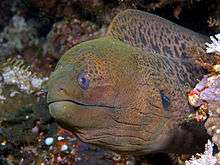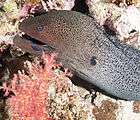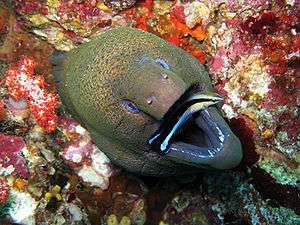Giant moray
| Giant moray | |
|---|---|
 | |
| Scientific classification | |
| Kingdom: | Animalia |
| Phylum: | Chordata |
| Class: | Actinopterygii |
| Order: | Anguilliformes |
| Family: | Muraenidae |
| Genus: | Gymnothorax |
| Species: | G. javanicus |
| Binomial name | |
| Gymnothorax javanicus (Bleeker, 1859) | |
The giant moray (Gymnothorax javanicus) is a species of moray eel and a species of marine fish in the family Muraenidae. In terms of body mass, it is the largest moray eel (the slender giant moray is longer).[1]
Description
As the name suggests, it is a large eel, reaching up to 3 m (9.8 ft) in length and 30 kg (66 lb) in weight.[2] Its serpent-shaped body has a brownish background color. While juveniles are tan in color with large black spots, adults have black specks that grade into leopard-like spots behind the head and a black area surrounding the gill opening.[3]
Distribution and habitat
The giant moray is widespread in the Indo-Pacific region, being found from eastern coast of Africa, Red Sea included, until the Pitcairn group, Hawaiian islands and also Polynesia. North to south Japan and south to New Caledonia, Fiji and the Austral Islands.[4]
It lives in lagoons and on the outer slopes of coral reefs, during the day it sits sheltered in crevices between 1 and 50 meters deep.[5]
Biology
The giant moray is carnivorous. It leaves its lair at night to actively hunt its prey along the reef. It mainly feeds on fish and occasionally on crustaceans.[6] It is known to engage in cooperative hunting with the roving coral grouper (Plectropomus pessuliferus).[7] This moray eel was recently identified as natural predator of the lionfish Pterois miles in its native habitat in the Red Sea.[8]
Hazards
This species may be hazardous to people. Being at the top of the food chain, it is likely to cause ciguatera poisoning if eaten.[1][3] It has been implicated in provoked and unprovoked attacks on scuba divers.[1][3][9]
 Giant moray with cleaner wrasse
Giant moray with cleaner wrasse Getting cleaned
Getting cleaned- Giant moray from the Red Sea
References
- 1 2 3 Lieske, E. and Myers, R.F. (2004) Coral reef guide; Red Sea London, HarperCollins ISBN 0-00-715986-2
- ↑ Lieske, E. and R. Myers, 1994. Collins Pocket Guide. Coral reef fishes. Indo-Pacific & Caribbean including the Red Sea. Harper Collins Publishers, 400 p.
- 1 2 3 Froese, Rainer and Pauly, Daniel, eds. (2007). "Gymnothorax javanicus" in FishBase. 5 2007 version.
- ↑ Fricke, R., 1999. Fishes of the Mascarene Islands (Réunion, Mauritius, Rodriguez): an annotated checklist, with descriptions of new species. Koeltz Scientific Books, Koenigstein, Theses Zoologicae, Vol. 31:759 p.
- ↑ Kuiter, R.H. and T. Tonozuka, 2001. Pictorial guide to Indonesian reef fishes. Part 1. Eels- Snappers, Muraenidae - Lutjanidae. Zoonetics, Australia. 302 p.
- ↑ Kuiter, R.H., 1998. Photo guide to fishes of the Maldives. Atoll Editions, Victoria, Australia. 257 p.
- ↑ Bshary R, Hohner A, Ait-el-Djoudi K, Fricke H (Dec 2006). "Interspecific communicative and coordinated hunting between groupers and giant moray eels in the Red Sea". PLoS Biol. 4 (12): e431. doi:10.1371/journal.pbio.0040431. PMC 1750927. PMID 17147471.
- ↑ Bos A.R., Sanad A.M., Elsayed K. (2017). "Gymnothorax spp. (Muraenidae) as natural predators of the lionfish Pterois miles in its native biogeographical range". Environmental Biology of Fishes. 100 (6): 745–748. doi:10.1007/s10641-017-0600-7.
- ↑ Siliotti, A. (2002) fishes of the red sea Verona, Geodia ISBN 88-87177-42-2